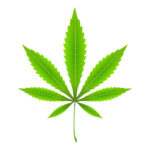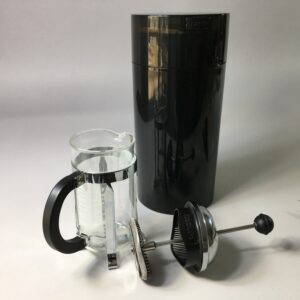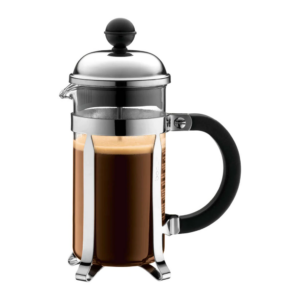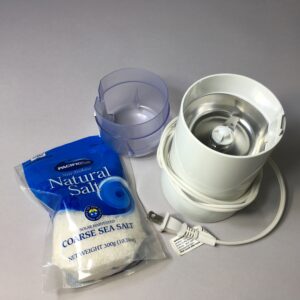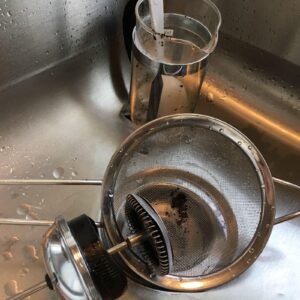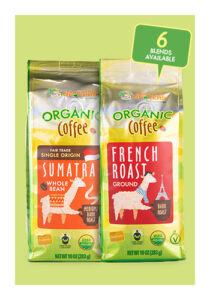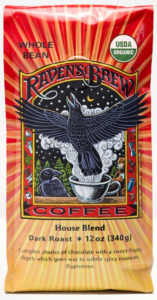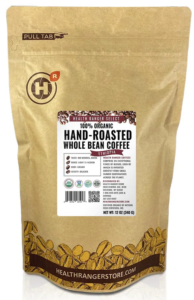Ray Peat’s Newsletter article on Caffeine (Coffee) is posted below in it’s entirety.
All discussions above his Newsletter are based on my own opinions and interpretations of my notes taken from his work and what I have found useful for my own use as well as from feedback from many, many, many, many others.
Here is the link for more information about other real foods.
I consume about 1 cup of ORGANIC, fresh brewed coffee per day made into one drink in the morning (brewed as 2 TBL grounds to 4 oz water and added to warmed raw milk). I use little water for brewing that much coffee (or sometimes only 2 oz. water with a heaping TBL coffee grounds) because I want a bit stronger brew and will be adding it to 3/4 cup of the warmed raw milk. It makes the drink more coffee flavored.
Those two or 2 and a half brewed Tablespoons-full of coffee will give you about 15 mg of “entourage” (more holistic, healthful, in combo with other micro-nutrient) magnesium. And the caffeine present will support the thyroid.
Caffeine: Per Peat: “with protein & thyroid, are good long-range protectants against estrogenic and carcinogenic influences.”
Can help reduce or eliminate migraine or other headaches. (L.)
I suggest not ingesting any additional caffeinated drinks (including caffeinated teas too) you are additionally used to drinking daily. You are mixing medicines if you do that.
Remember teas are infusions of other plants, herbs that include their own forms of medicines in those brews.
Many of these innocuous seeming teas can be poisonous or toxic even when they have been marketed to us for decades as if they are just any, safe old beverage. THEY MIGHT NOT BE so harmless!
If you are having mystery ailments and pain, I suggest ending the tea drinking for awhile and try the coffee with the rest of the daily, real food suggestions.
For some people, if tolerated, I have interpreted Peat to suggest up to 5 servings of coffee per day taken as one serving per meal, is acceptable.
NOTE: I did not mean “cups” of coffee, but rather “servings”.
I think a serving per Peat is about 2 ounces of prepared coffee per meal, and still combined with good quality cream in the mug. This is approximately 1/4th cup measuring cup of coffee per serving.
In addition, adding to the coffee high quality, raw milk cream (2 TBLE) and/or 3/4-cup raw milk creates a chemical reaction that helps the coffee be easier to digest, easier for the body to correctly utilize the coffee nutrients, easier on the stomach, with low to no “caffeine jitters”.
NEVER use in your coffees any substitute “milks”, nut milks, soy, powdered commercial coffee creamers or such. These all are highly, highly toxic poisons.
Never ingest coffee made from those pod coffee machines, often flavored, from coffee grounds in plastic “pods/capsules”.
Never ingest any “flavored” coffee however made. These brews are all highly chemically toxic.
If you are used to drinking more coffee than the recommended amounts during the day, do so but as you begin to heal the thyroid with proper food and supplements you might need less and less. I suggest a good goal is only two cups a day but work into that. Some studies report a loss of vital nutrients when consuming an excess of caffeinated coffee.
Monitor your intake of coffee for side effects of nervousness or too rapid heartbeat especially when used in combination with other supplements like vitamin D and thyroid meds/supplements. Using high quality cream or milk in the coffee can often resolve these issues.
One normal cup of coffee is approximately two to two and a half TBLE (tablespoons) of coarse ground, roasted coffee beans brewed into about 6-8 oz. of water.
For my taste, as stated above, I use two TBLEs roasted, coarse ground coffee beans to only 4 oz. of hot (not quite boiling but just to the point) water and I use a French press to make it. I then add about 6 oz. of warm raw milk to the finished coffee in a warmed mug.
Find ORGANIC coffee (and from a trusted company known for processing without chemicals) roasted whole bean coffee.
Buy coffee as fresh as possible and whole, and grind it just before use or using a commercial grinder in the store where purchased, grinding just enough coffee to last a week or two. In a grocery or coffee store, the freshest is often in the bulk containers rather than the pre-packaged shelf bags.
I suggest particularly not buying pre-packaged coffees that are already ground. It often seems the ground coffee packaged versions are older. The beans are possibly rancid now (coffee beans are a bit oily). Grinding exposes the oils and coffee fruit to more air causing the coffee to not only be tasteless, but possibly have rancidity toxins.
As well, packages of ground coffee are usually ground only to the grind-size for use in filtered coffee machines, not the coarse grind needed for say French press setups.
HACK: Good equipment to have to hand:
Buy a counter-top air tight coffee storage container for daily use that keeps out air as much as possible by using such a container. I use the plastic Tightvac coffee storage container while leaving the coffee in the paper coffee packaging, opened, instead of pouring the grounds into the container and touching the plastic container.
As a heads up, I’ve used this storage container for years but pressing the button and grasping the lid to use it is getting more painful as my hands have progressed in their arthritis. If you have such hands, I suggest looking for a different-opening cannister idea instead. I haven’t yet switched mine out, but will sooner than later.
Other coffee home storage cannister ideas can be found here and here.
Try to buy directly from the sellers and manufacturers of the containers rather than through a big-box store.
For just you, have a small (2-3 cup) coffee French press maker. I use a glass Boden French Press. The company link shows an easy how-to-make guide.
RECIPE: Single Serve French Press Coffee
Here is a single serve French Press Coffee recipe that you can depend on regardless of the press or the coffee beans that you have in your home. Consider this your fully adaptable recipe for all shapes and seasons!
For 8 oz. cup of coffee you will need:
(TIP: prep everything right before you’ll start)
- One Cup French Press Coffee Maker
- 17 g. (~2-2.5 tbsp.) Coarse Ground Coffee
- 8 oz. (237 ml.) Water
- Stirring spoon
- Timer
- Coffee Mug
STEP by STEP BREW GUIDE
- Start with water that is just about to boil, but not quite. You can start with boiling water, then let it cool for a bit (let it rest for 1 min.).
- Grind your coffee beans fresh. This is an essential step to a great one cup. A fresh grind is always better than instant beans or old beans.
- Always use a coarse grind, not a fine one! A coarse grind keeps the beans from escaping into the filter, and it also maintains the flavor more effectively.
- The rule is two tbsp. coffee, one cup water (8 oz.). Regardless of the type of beans you have, this is the mix that will give you a great flavor without overpowering you. Of course, if you want a stronger mix, you can certainly negotiate this ratio!
- Pour water evenly over beans, stir and cover. You want to be sure that the water is hitting all of the beans evenly. STIR SLOWLY FOR ABOUT 1 MINUTE of the 4 minutes for steeping. Cover the mix immediately so that you do not lose flavor from the “head,” so to speak.
- 4 minute steep. This is another general rule that always works. Four minutes is the magic mark!
- Press down on the plunger evenly. Press from a straight vertical angle to keep the grounds from leaking out of the side of the filter. There is no rush, so go slowly if you do not want the dust from the mix to stir up.
- Pour and wash. Pour the coffee into your cup and wash your French Press (wash only with water after spooning the spent grounds into a compost bag).
I have purchased (and store-ground the packaged beans) more coffee than I could use in a couple weeks. I store it in the freezer. It should still be used within 3 months or less as the oils and beans start to degrade from moisture and air even in the freezer.
Many purchase their own in-home coffee grinder. I use the commercial grinder at the Natural Grocers to grind up an 8-12 oz. bag of coffee at a purchase.
More COFFEE HACKS: If you purchase and use your own coffee grinder, use it ONLY for coffee, not to grind cannabis or powder salt. Buy a 2nd grinder for other uses.
HACK: Never put any of your coffee tools through a dishwasher (which leaves residue), or wash with dish soap/detergent—do not soap-wash your French press or your grinder or your stir spoons. Only use water and a clean sponge/cloth to clean them.
HACK: If using a french press, be sure to never rinse your spent ground coffee down a drain. It usually will not move all the way through the plumbing but rather will build up in all the dips along the way and at some point could cause a sewer or drain backup. I first scoop out much of the grounds from the glass into my compost bag. I then use my fine mesh strainer and rinse my coffee press materials over the strainer catching a lot more of the grounds. These I also then dump into the compost bag, keeping most of the grounds from going down the drain.
Here are some places to look for organic, tested-clean coffee:
The Natural Grocers sells an organic Fair Trade brand that I like—in bulk (I can decant as much or little into supplied paper coffee bags by their commercial grinder), so it’s fresher rather than pre-bagged on the shelf.
Also, Raven’s Brew makes an exquisitely tasteful organic coffee called Raven’s Brew House Blend (be sure to select the “organic” version) that is a dark roast.
And this online location carries contaminant-free-tested coffee. I purchase many other food items from them because they test everything to be glyphosate and other contaminants free.
While one of the pricier options, their products are the cleanest I’ve been able to find. Their Guatamalan beans are tested and can arrive fresh roasted, or green if you want to experiment with roasting your own, or want to store the beans longer as part of your emergency food supplies.
The Health Ranger has certified organic and tested glyphosate free whole bean coffees in different tastes and quantities.
The Health Ranger also sells freeze-dried instant coffee that is tested glyphosate free and contaminates free. However, I don’t know if all the nutrients survive the process in the same measures. I would think they do but I have no way of testing or knowing this. A 3-oz package of freeze dried coffee is about 18 servings (18 teaspoons).
One teaspoon of dried coffee per 6-8 oz hot water is the usual measure per serving. High quality raw milk or raw milk cream would be added to the freeze dried version coffee and drink as the suggestion in any case.
(Use caution at the Health Ranger. I’m completely grateful they test ALL their offerings’ lots they sell to be glyphosate and toxins free. However, many of the supplement and food and other items listed there I cannot recommend because of other issues, such as in my opinion, the supplement or food in general not being good for most people to ingest in any form. Many “health gurus” are just wrong in their beliefs of what is healthy or not. This is why over the decades many of us return again and again to learn from Peat.)
That said, there are also some highly beneficial coffee blends sold with included mushroom powders for immune support. Be sure the mushrooms are also organic and tested glyphosate-free and no other additives, sweeteners or anything other than coffee and mushroom powders are in the mix.

A R T I C L E
Caffeine: A vitamin-like nutrient, or adaptogen
Questions about tea and coffee, cancer and other degenerative diseases, and the hormones.
There is a popular health-culture that circulates mistaken ideas about nutrition, and coffee drinking has been a perennial target of this culture. It is commonly said that coffee is a drug, not a food, and that its drug action is harmful, and that this harm is not compensated by any nutritional benefit. Most physicians subscribe to most of these “common sense” ideas about coffee, and form an authoritative barrier against the assimilation of scientific information about coffee.
I think it would be good to reconsider coffee’s place in the diet and in health care.
Coffee drinkers have a lower incidence of thyroid disease, including cancer, than non-drinkers.
Caffeine protects the liver from alcohol and acetaminophen (Tylenol) and other toxins, and coffee drinkers are less likely than people who don’t use coffee to have elevated serum enzymes and other indications of liver damage.
Caffeine protects against cancer caused by radiation, chemical carcinogens, viruses, and estrogens.
Caffeine synergizes with progesterone, and increases its concentration in blood and tissues.
Cystic breast disease is not caused by caffeine, in fact caffeine’s effects are likely to be protective; a variety of studies show that coffee, tea, and caffeine are protective against breast cancer.
Coffee provides very significant quantities of magnesium, as well as other nutrients including vitamin B1.
Caffeine “improves efficiency of fuel use” and performance: JC Wagner 1989.
Coffee drinkers have a low incidence of suicide.
Caffeine supports serotonin uptake in nerves, and inhibits blood platelet aggregation.
Coffee drinkers have been found to have lower cadmium in tissues; coffee making removes heavy metals from water.
Coffee inhibits iron absorption if taken with meals, helping to prevent iron overload.
Caffeine, like niacin, inhibits apoptosis, protecting against stress-induced cell death, without interfering with normal cell turnover.
Caffeine can prevent nerve cell death.
Coffee (or caffeine) prevents Parkinson’s Disease (Ross, et al., 2000).
The prenatal growth retardation that can be caused by feeding large amounts of caffeine is prevented by supplementing the diet with sugar.
Caffeine stops production of free radicals by inhibiting xanthine oxidase, an important factor in tissue stress.
Caffeine lowers serum potassium following exercise; stabilizes platelets, reducing thromboxane production.
One definition of a vitamin is that it is an organic chemical found in foods, the lack of which causes a specific disease, or group of diseases. A variety of substances that have been proposed to be vitamins haven’t been recognized as being essential, and some substances that aren’t essential are sometimes called vitamins. Sometimes these issues haven’t had enough scientific investigation, but often nonscientific forces regulate nutritional ideas.
The definition of “a disease” isn’t as clear as text-book writers have implied, and “causality” in biology is always more complex than we like to believe.
Nutrition is one of the most important sciences, and should certainly be as prestigious and well financed as astrophysics and nuclear physics, but while people say “it doesn’t take a brain surgeon to figure that out,” no one says “it doesn’t take a nutritionist to understand that.” Partly, that’s because medicine treated scientific nutrition as an illegitimate step-child, and refused throughout the 20th century to recognize that it is a central part of scientific health care. In the 1970s, physicians and dietitians were still ridiculing the idea that vitamin E could prevent or cure diseases of the circulatory system, and babies as well as older people were given “total intravenous nutrition” which lacked nutrients that are essential to life, growth, immunity, and healing. Medicine and science are powerfully institutionalized, but no institution or profession has existed for the purpose of encouraging people to act reasonably.
In this environment, most people have felt that subtleties of definition, logic and evidence weren’t important for nutrition, and a great amount of energy has gone into deciding whether there were “four food groups” or “seven food groups” or a “nutritional pyramid.” The motives behind governmental and quasi-governmental nutrition policies usually represent something besides a simple scientific concern for good health, as when health care institutions say that Mexican babies should begin eating beans when they reach the age of six months, or that non-whites don’t need milk after they are weaned. In a culture that discourages prolonged breast feeding, the effects of these doctrines can be serious.
After a century of scientific nutrition, public nutritional policies are doing approximately as much harm as good, and they are getting worse faster than they are getting better..
In this culture, what we desperately need is a recognition of the complexity of life, and of the political-ecological situation we find ourselves in. Any thinking which isn’t “system thinking” should be treated with caution, and most contemporary thinking about health neglects to consider relevant parts of the problem-system. “Official” recommendations about salt, cholesterol, iron, unsaturated and saturated fats, and soybeans have generally been inappropriate, unscientific, and strongly motivated by business interests rather than by biological knowledge.
Definitions have rarely distinguished clearly between nutrients and drugs, and new commercial motives are helping to further blur the distinctions.
Essential nutrients, defensive (detoxifying, antistress) nutrients, hormone-modulating nutrients, self-actualization nutrients, growth regulating nutrients, structure modifiers, life extension agents, transgenerationally active (imprinting) nutrients–the line between nutrients and biological modifiers often depends on the situation. Vitamins D and A clearly have hormone-like properties, and vitamin E’s effects, and those of many terpenoids and steroids and bioflavonoids found in foods, include hormone-like actions as well as antioxidant and pro-oxidant functions. The concept of “adaptogen” can include things that act like both drugs and nutrients.
Some studies have suggested that trace amounts of nutrients could be passed on for a few generations, but the evidence now indicates that these transgenerational effects are caused by phenomena such as “imprinting.” But the hereditary effects of nutrients are so complex that their recognition would force nutrition to be recognized as one of the most complex sciences, interwoven with the complexities of growth and development.
The idea that poor nutrition stunts growth has led to the idea that good nutrition can be defined in terms of the rate of growth and the size ultimately reached. In medicine, it is common to refer to an obese specimen as “well nourished,” as if quantity of food and quantity of tissue were necessarily good things. But poisons can stimulate growth (“hormesis”), and food restriction can extend longevity. We still have to determine basic things such as the optimal rate of growth, and the optimal size.
Nutrition textbooks flatly describe caffeine as a drug, not a nutrient, as if it were obvious that nutrients can’t be drugs. Any of the essential nutrients, if used in isolation, can be used as a drug, for a specific effect on the organism that it wouldn’t normally have when eaten as a component of ordinary food. And natural foods contain thousands of chemicals, other than the essential nutrients. Many of these are called nonessential nutrients, but their importance is being recognized increasingly. The truth is that we aren’t sure what they “aren’t essential” for. Until we have more definite knowledge about the organism I don’t think we should categorize things so absolutely as drugs or nutrients.
The bad effects ascribed to coffee usually involve administering large doses in a short period of time. While caffeine is commonly said to raise blood pressure, this effect is slight, and may not occur during the normal use of coffee. Experimenters typically ignore essential factors. Drinking plain water can cause an extreme rise in blood pressure, especially in old people, and eating a meal (containing carbohydrate) lowers blood pressure. The increased metabolic rate caffeine produces increases the cellular consumption of glucose, so experiments that study the effects of coffee taken on an empty stomach are measuring the effects of increased temperature and metabolic rate, combined with increased adrenaline (resulting from the decrease of glucose), and so confuse the issue of caffeine’s intrinsic effects.
In one study (Krasil’nikov, 1975), the drugs were introduced directly into the carotid artery to study the effects on the blood vessels in the brain. Caffeine increased the blood volume in the brain, while decreasing the resistance of the vessels, and this effect is what would be expected from its stimulation of brain metabolism and the consequent increase in carbon dioxide, which dilates blood vessels.
In the whole body, increased carbon dioxide also decreases vascular resistance, and this allows circulation to increase, while the heart’s work is decreased, relative to the amount of blood pumped. But when the whole body’s metabolism is increased, adequate nutrition is crucial.
In animal experiments that have been used to argue that pregnant women shouldn’t drink coffee, large doses of caffeine given to pregnant animals retarded the growth of the fetuses. But simply giving more sucrose prevented the growth retardation. Since caffeine tends to correct some of the metabolic problems that could interfere with pregnancy, it is possible that rationally constructed experiments could show benefits to the fetus from the mother’s use of coffee, for example by lowering bilirubin and serotonin, preventing hypoglycemia, increasing uterine perfusion and progesterone synthesis, synergizing with thyroid and cortisol to promote lung maturation, and providing additional nutrients.
One of the most popular misconceptions about caffeine is that it causes fibrocystic breast disease. Several groups demonstrated pretty clearly that it doesn’t, but there was no reason that they should have had to bother, except for an amazingly incompetent, but highly publicized, series of articles–classics of their kind–by J. P. Minton, of Ohio State University. Minton neglected to notice that the healthy breast contains a high percentage of fat, and that the inflamed and diseased breast has an increased proportion of glandular material Fat cells have a low level of cyclic AMP, a regulatory substance that is associated with normal cellular differentiation and function, and is involved in mediating caffeine’s ability to inhibit cancer cell multiplication. Minton argued that cAMP increases progressively with the degree of breast disease, up to cancer, and that cAMP is increased by caffeine. A variety of substances other than caffeine that inhibit the growth of cancer cells (as well as normal breast cells) act by increasing the amount of cyclic AMP, while estrogen lowers the amount of cAMP and increases cell growth. Minton’s argument should have been to use more caffeine, in proportion to the degree of breast disease, if he were arguing logically from his evidence. Caffeine’s effect on the breast resembles that of progesterone, opposing estrogen’s effects.
Many studies over the last 30 years have shown caffeine to be highly protective against all kinds of carcinogenesis, including estrogen’s carcinogenic effects on the breast. Caffeine is now being used along with some of the standard cancer treatments, to improve their effects or to reduce their side effects. There are substances in the coffee berry besides caffeine that protect against mutations and cancer, and that have shown strong therapeutic effects against cancer. Although many plant substances are protective against mutations and cancer, I don’t know of any that is as free of side effects as coffee.
To talk about caffeine, it’s necessary to talk about uric acid. Uric acid, synthesized in the body, is both a stimulant and a very important antioxidant, and its structure is very similar to that of caffeine. A deficiency of uric acid is a serious problem. Caffeine and uric acid are in the group of chemicals called purines.
Purines (along with pyrimidines) are components of the nucleic acids, DNA and RNA, but they have many other functions. In general, substances related to purines are stimulants, and substances related to pyrimidines are sedatives.
When the basic purine structure is oxidized, it becomes in turn hypoxanthine, xanthine, and uric acid, by the addition of oxygen atoms. When methyl groups (CH3) are added to nitrogens in the purine ring, the molecule becomes less water soluble. Xanthine (an intermediate in purine metabolism) has two oxygen atoms, and when three methyl groups are added, it becomes trimethyl xanthine, or caffeine. With two methyl groups, it is theophylline, which is named for its presence in tea. We have enzyme systems which can add and subtract methyl groups; for example, when babies are given theophylline, they can convert it into caffeine.
We have enzymes that can modify all of the methyl groups and oxygen atoms of caffeine and the other purine derivatives. Caffeine is usually excreted in a modified form, for example as a methylated uric acid.
One of the ways in which uric acid functions as an “antioxidant” is by modifying the activity of the enzyme xanthine oxidase, which in stress can become a dangerous source of free radicals. Caffeine also restrains this enzyme. There are several other ways in which uric acid and caffeine (and a variety of intermediate xanthines) protect against oxidative damage. Coffee drinkers, for example, have been found to have lower levels of cadmium in their kidneys than people who don’t use coffee, and coffee is known to inhibit the absorption of iron by the intestine, helping to prevent iron overload.
Toxins and stressors often kill cells, for example in the brain, liver, and immune system, by causing the cells to expend energy faster than it can be replaced. There is an enzyme system that repairs genetic damage, called “PARP.” The activation of this enzyme is a major energy drain, and substances that inhibit it can prevent the death of the cell. Niacin and caffeine can inhibit this enzyme sufficiently to prevent this characteristic kind of cell death, without preventing the normal cellular turnover; that is, they don’t produce tumors by preventing the death of cells that aren’t needed.
The purines are important in a great variety of regulatory processes, and caffeine fits into this complex system in other ways that are often protective against stress. For example, it has been proposed that tea can protect against circulatory disease by preventing abnormal clotting, and the mechanism seems to be that caffeine (or theophylline) tends to restrain stress-induced platelet aggregaton.
When platelets clump, they release various factors that contribute to the development of a clot. Serotonin is one of these, and is released by other kinds of cell, including mast cells and basophils and nerve cells. Serotonin produces vascular spasms and increased blood pressure, blood vessel leakiness and inflammation, and the release of many other stress mediators. Caffeine, besides inhibiting the platelet aggregation, also tends to inhibit the release of serotonin, or to promote its uptake and binding.
- W. Davis, et al., 1996, found that high uric acid levels seem to protect against the development of Parkinson’s disease. They ascribed this effect to uric acid’s antioxidant function. Coffee drinking, which lowers uric acid levels, nevertheless appeared to be much more strongly protective against Parkinson’s disease than uric acid.
Possibly more important than coffee’s ability to protect the health is the way it does it. The studies that have tried to gather evidence to show that coffee is harmful, and found the opposite, have provided insight into several diseases. For example, coffee’s effects on serotonin are very similar to carbon dioxide’s, and the thyroid hormone’s. Noticing that coffee drinking is associated with a low incidence of Parkinson’s disease could focus attention on the ways that thyroid and carbon dioxide and serotonin, estrogen, mast cells, histamine and blood clotting interact to produce nerve cell death.
Thinking about how caffeine can be beneficial across such a broad spectrum of problems can give us a perspective on the similarities of their underlying physiology and biochemistry, expanding the implications of stress, biological energy, and adaptability.
The observation that coffee drinkers have a low incidence of suicide, for example, might be physiologically related to the large increase in suicide rate among people who use the newer antidepressants called “serotonin reuptake inhibitors.” Serotonin excess causes several of the features of depression, such as learned helplessness and reduced metabolic rate, while coffee stimulates the uptake (inactivation or storage) of serotonin, increases metabolic energy, and tends to improve mood. In animal studies, it reverses the state of helplessness or despair, often more effectively than so-called antidepressants.
The research on caffeine’s effects on blood pressure, and on the use of fuel by the more actively metabolizing cells, hasn’t clarified its effects on respiration and nutrition, but some of these experiments confirm things that coffee drinkers usually learn for themselves.
Often, a woman who thinks that she has symptoms of hypoglycemia says that drinking even the smallest amount of coffee makes her anxious and shaky. Sometimes, I have suggested that they try drinking about two ounces of coffee with cream or milk along with a meal. It’s common for them to find that this reduces their symptoms of hypoglycemia, and allows them to be symptom-free between meals. Although we don’t know exactly why caffeine improves an athlete’s endurance, I think the same processes are involved when coffee increases a person’s “endurance” in ordinary activities.
Caffeine has remarkable parallels to thyroid and progesterone, and the use of coffee or tea can help to maintain their production, or compensate for their deficiency. Women spontaneously drink more coffee premenstrually, and since caffeine is known to increase the concentration of progesterone in the blood and in the brain, this is obviously a spontaneous and rational form of self-medication, though medical editors like to see things causally reversed, and blame the coffee drinking for the symptoms it is actually alleviating. Some women have noticed that the effect of a progesterone supplement is stronger when they take it with coffee. This is similar to the synergy between thyroid and progesterone, which is probably involved, since caffeine tends to locally activate thyroid secretion by a variety of mechanisms, increasing cyclic AMP and decreasing serotonin in thyroid cells, for example, and also by lowering the systemic stress mediators.
Medical editors like to publish articles that reinforce important prejudices, even if, scientifically, they are trash. The momentum of a bad idea can probably be measured by the tons of glossy paper that have gone into its development. Just for the sake of the environment, it would be nice if editors would try to think in terms of evidence and biological mechanisms, rather than stereotypes.
REFERENCES
Fiziol Zh SSSR Im I M Sechenova 1975 Oct;61(10):1531-8. [Changes in the resistance and capacity of the cerebral vascular bed under the influence of vasoactive substances]. [Article in Russian] Krasil’nikov, V.G. Effects of intracarotid injections of vasoactive agents on cerebrovascular resistance (CVR) and cerebral blood volume (CBV) were studied in hemodynamically isolated brain of cats. Perfusion pressure shifts at a constant blood volume perfusion reflected CVR changes, and changes of venous outflow – CBV alterations. Administration of adrenaline, serotonin, and angiotensine was followed mainly by an increase of CVR and a decrease of CBV. The CVR could be reduced by isopropilnoradrenaline, acetylcholine, histamine, and caffeine. CBV was decreased after isopropilnoradrenaline, acetycholine, histamine injections and increased by caffeine. The possible role of the active changes of cerebral capacitance vessels in the transcapillary fluid exchange is discussed. Capacitance vessels active responses are supposed to entail wrong results when using certain techniques for measurement of cerebral blood flow and metabolism.
Proc Soc Exp Biol Med 1999 Apr;220(4):244-8. The prevention of lung cancer induced by a tobacco-specific carcinogen in rodents by green and black Tea. Chung FL “The oxidation products found in black tea, thearubigins and theaflavins, also possess antioxidant activity, suggesting that black tea may also inhibit NNK-induced lung tumorigenesis. Indeed, bioassays in A/J mice have shown that black tea given as drinking water retarded the development of lung cancer caused by NNK.” “We conducted a 2-year lifetime bioassay in F344 rats to determine whether black tea and caffeine are protective against lung tumorigenesis induced by NNK. Our studies in both mice and rats have generated important new data that support green and black tea and caffeine as potential preventive agents against lung cancer, suggesting that a closer examination of the roles of tea and caffeine on lung cancer in smokers may be warranted.”
Pharmacol Biochem Behav 2000 May;66(1):39-45. Caffeine-induced increases in the brain and plasma concentrations of neuroactive steroids in the rat. Concas A, Porcu P, Sogliano C, Serra M, Purdy RH, Biggio G. “A single intraperitoneal injection of caffeine induced dose- and time-dependent increases in the concentrations of pregnenolone, progesterone, and 3alpha-hydroxy-5alpha-pregnan-20-one (allopregnanolone) in the cerebral cortex.” “Caffeine also increased the plasma concentrations of pregnenolone and progesterone with a dose-response relation similar to that observed in the brain . . .” “Moreover, the brain and plasma concentrations of pregnenolone, progesterone, and allopregnanolone were not affected by caffeine in adrenalectomized-orchiectomized rats.”
Cancer Res 1998 Sep 15;58(18):4096-101. Inhibition of lung carcinogenesis by black tea in Fischer rats treated with a tobacco-specific carcinogen: caffeine as an important constituent. Chung FL, Wang M, Rivenson A, Iatropoulos MJ, Reinhardt JC, Pittman B, Ho CT, Amin SG. “The NNK-treated group, given 2% black tea, showed a significant reduction of the total lung tumor (adenomas, adenocarcinomas, and adenosquamous carcinomas) incidence from 47% to 19%, whereas the group given 1% and 0.5% black tea showed no change. The 2% tea also reduced liver tumor incidence induced by NNK from 34% in the group given only deionized water to 12%.” “The most unexpected finding was the remarkable reduction of the lung tumor incidence, from 47% to 10%, in the group treated with 680 ppm caffeine, a concentration equivalent to that found in the 2% tea. This incidence is comparable to background levels seen in the control group. This study demonstrated for the first time in a 2-year lifetime bioassay that black tea protects against lung tumorigenesis in F344 rats, and this effect appears to be attributed, to a significant extent, to caffeine as an active ingredient of tea.”
Cancer Lett 1991 Mar;56(3):245-50. Inhibition by caffeine of ovarian hormone-induced mammary gland tumorigenesis in female GR mice. VanderPloeg LC, Welsch CW. “Hormone treatment induced mammary tumors in 95-100% of the mice. Caffeine treatment significantly (P less than 0.05) reduced the mean number of mammary tumors per mouse and significantly (P less than 0.05) increased the mean latency period of mammary tumor appearance.”
Breast Cancer Res Treat 1991 Nov;19(3):269-75. Caffeine inhibits development of benign mammary gland tumors in carcinogen-treated female Sprague-Dawley rats. Wolfrom DM, Rao AR, Welsch CW.
Cancer 1985 Oct 15;56(8):1977-81. The inhibitory effect of caffeine on hormone-induced rat breast cancer. Petrek JA, Sandberg WA, Cole MN, Silberman MS, Collins DC. “The current investigation examines the effect of two caffeine doses in ACI rats with and without diethylstilbestrol (DES). Without DES, cancer did not develop in any of the rats receiving either of the two caffeine dosages. With DES, increasing caffeine dosage lengthened the time to first cancer, decreased the number of rats that developed cancers, and decreased the number of cancers overall.” “In conclusion, chronic caffeine ingestion inhibits rat breast cancer, neither by interfering with the high prolactin levels–a necessary step in murine tumor development–nor by causing hypocaloric intake.”
Nutr Cancer 1998;30(1):21-4. Association of coffee, green tea, and caffeine intakes with serum concentrations of estradiol and sex hormone-binding globulin in premenopausal Japanese women. Nagata C, Kabuto M, Shimizu H. “Although the effect of caffeine cannot be distinguished from effects of coffee and green tea, consumption of caffeine-containing beverages appeared to favorably alter hormone levels associated with the risk of developing breast cancer.”
J Environ Pathol Toxicol Oncol 1992; 11(3):177-89. Caffeine, theophylline, theobromine, and developmental growth of the mouse mammary gland. VanderPloeg LC, Wolfrom DM, Rao AR, Braselton WE, Welsch CW. “These data demonstrate that certain methylxanthines (e.g., caffeine and theophylline) but not others (e.g., theobromine) can significantly enhance mammotrophic hormone-induced mammary lobulo-alveolar differentiation in female Balb/c mice, an effect that appears not to be manifested via a direct action of the methylxanthines on the mammary gland.”
J Environ Pathol Toxicol Oncol 1994;13(2):81-8. Enhancement by caffeine of mammary gland lobulo-alveolar development in mice: a function of increased corticosterone. Welsch CW, VanderPloeg LC. Previously we have reported that the stimulatory effect of caffeine on lobulo-alveolar development in the mammary glands of female Balb/c mice is not due to a direct action of the drug on the mammary gland but appears to be due to a caffeine-induced alteration of a yet to be defined systemic physiological process (VanderPloeg et al., J Environ Pathol Toxicol Oncol 11:177-189, 1992). “In the present study, we administered caffeine (via the drinking water, 500 mg/L) to ovariectomized, estrogen- and progesterone-treated Balb/c mice. After 30 days of caffeine treatment, a significant (p < 0.001) enhancement of lobulo-alveolar development in the mammary glands of the hormone-treated mice, compared with hormone treated control mice, was observed.”
Am J Clin Nutr 1997 Jun;65(6):1826-30. Dietary caffeine intake and bone status of postmenopausal women. Lloyd T, Rollings N, Eggli DF, Kieselhorst K, Chinchilli VM.
Eur J Epidemiol 1993 May;9(3):293-7. Unexpected effects of coffee consumption on liver enzymes. Casiglia E, Spolaore P, Ginocchio G, Ambrosio GB. Istituto di Medicina Clinica, Universita di Padova, Italy. The effects of regular daily coffee consumption on liver enzymes were studied in a large number of subjects from the general population. In coffee drinkers, liver enzymes (gamma-glutamyl transferase, alanine-amino transferase, and alkaline phosphatase) and serum bilirubin were lower than in non-coffee-drinking subjects or in those consuming less than 3 cups daily. The hypothesis proposed is that liver enzymes are a target for caffeine contained in coffee.
Anticancer Res 1996 Jan-Feb;16(1):151-3 Suppression by coffee cherry of the growth of spontaneous mammary tumours in SHN mice. Nagasawa H, Yasuda M, Sakamoto S, Inatomi H Experimental Animal Research Laboratory, Meiji University, Kanagawa, Japan. We previously found that coffee cherry (CC), residue after removal of coffee beans, significantly suppressed the development of spontaneous mammary tumours of mice. In this paper, the effects of CC on the growth of the palpable size of this type of tumour was examined. Free access as drinking water of 0.5% solution of the hot water extract of CC for 10 days resulted in a marked inhibition of the tumour growth: The percent changes of tumour sizes were 53.8 +/- 11.7% and 13.8 +/- 10.9% in the control and the experimental groups, respectively. Associated with this, thymidylate synthetase activity in the mammary tumours was significantly lower in the experimental group than in the control. Normal and preneoplastic mammary gland growth, body weight change and weights and structures of endocrine organs were only slightly affected by the treatment. The findings indicate that CC is promising as an antitumour agent.
Yakugaku Zasshi 1997 Jul;117(7):448-54. [Effect of tea extracts, catechin and caffeine against type-I allergic reaction]. [Article in Japanese] Shiozaki T, Sugiyama K, Nakazato K, Takeo T. “Caffeine also showed a inhibitory effect on the PCA reaction. These results indicate that tea could provide a significant protection against the type-I allergic reaction. These findings also suggest that tea catechins and caffeine play an important role in having an inhibitory effect on the type-I allergic reaction.”
Acta Chir Scand 1989 Jun-Jul;155(6-7):317-20. Does coffee consumption protect against thyroid disease? Linos A, Linos DA, Vgotza N, Souvatzoglou A, Koutras DA
Br J Nutr 1999 Aug;82(2):125-30. Inverse association between coffee drinking and serum uric acid concentrations in middle-aged Japanese males. Kiyohara C, Kono S, Honjo S, Todoroki I, Sakurai Y, Nishiwaki M, Hamada H, Nishikawa H, Koga H, Ogawa S, Nakagawa K
Cancer Res 1997 Jul 1;57(13):2623-9. Effects of tea, decaffeinated tea, and caffeine on UVB light-induced complete carcinogenesis in SKH-1 mice: demonstration of caffeine as a biologically important constituent of tea. Huang MT, Xie JG, Wang ZY, Ho CT, Lou YR, Wang CX, Hard GC, Conney A.H.
Mutat Res 1981 Jun;89(2):161-77. Non-mutagenicity of urine from coffee drinkers compared with that from cigarette smokers. Aeschbacher HU, Chappuis C.
Biol Neonate 1981;40(3-4):196-8. The effects of maternal carbohydrate (sucrose) supplementation on the growth of offspring of pregnancies with habitual caffeine consumption. Dunlop M, Court JM, Larkins RG. “When maternal caffeine (10 mg/kg/day) was consumed together with supplementary sucrose (7 g/kg/day) the expected offspring growth reduction attributed to caffeine did not occur.”
Biochim Biophys Acta 1992 Dec 15;1175(1):114-22. Caffeine promotes survival of cultured sympathetic neurons deprived of nerve growth factor through a cAMP-dependent mechanism. Tanaka S, Koike T.
JAMA 2000 May 24-31;283(20):2674-9. Association of coffee and caffeine intake with the risk of Parkinson disease. Ross GW, Abbott RD, Petrovitch H, Morens DM, Grandinetti A, Tung KH, Tanner CM, Masaki KH, Blanchette PL, Curb JD, Popper JS, White LR.
Farmakol Toksikol 1983 Sep-Oct;46(5):107-11 [Use of the swimming test for demonstrating antidepressive activity of drugs during single and repeated administration]. [Article in Russian] Rusakov DIu, Val’dman AV. “The use of the “swimming test” made it possible to identify the activity of tricyclic (desipramine, chlorimipramine, amitryptyline) and atypical antidepressants (befuralin, zimelidine, trazodon), that of pyrazidol (type A MAO inhibitor) and of a number of new compounds–derivatives of benzofuran and morpholine upon single and chronic administration. To define the method specificity, use was made of the neuroleptic haloperidol, the tranquilizer diazepam, and of nembutal, which did not exhibit any activity in the test in question. Psychostimulants (amphetamine, caffeine) dramatically increased the time of active swimming. The effect lasted throughout all the 30 minutes of testing, which is not characteristic for antidepressants.”
Gen Pharmacol 1996 Jan;27(1):167-70 The influence of antagonists of poly(ADP-ribose) metabolism on acetaminophen hepatotoxicity. Kroger H, Ehrlich W, Klewer M, Gratz R, Dietrich A, Miesel R.
Ann Clin Lab Sci 1977 Jan-Feb;7(1):68-72. Effects of drugs on platelet function. Morse EE.
Thromb Haemost 1982 Apr 30;47(2):90-5. Effect of cAMP phosphodiesterase inhibitors on ADP-induced shape change, cAMP and nucleoside diphosphokinase activity of rabbit platelets. Lam SC, Guccione MA, Packham MA, Mustard JF.
Carcinogenesis 1998 Aug;19(8):1369-75. The coffee-specific diterpenes cafestol and kahweol protect against aflatoxin B1-induced genotoxicity through a dual mechanism. Cavin C, Holzhauser D, Constable A, Huggett AC, Schilter B.
Am J Epidemiol 1994 Apr 1;139(7):723-7. Coffee and serum gamma-glutamyltransferase: a study of self-defense officials in Japan. Kono S, Shinchi K, Imanishi K, Todoroki I, Hatsuse K.
Carcinogenesis 1996 Nov;17(11):2377-84 Placental glutathione S-transferase (GST-P) induction as a potential mechanism for the anti-carcinogenic effect of the coffee-specific components cafestol and kahweol. Schilter B, Perrin I, Cavin C, Huggett AC
J Nutr 1999 Jul;129(7):1361-7. Teas and other beverages suppress D-galactosamine-induced liver injury in rats. Sugiyama K, He P, Wada S, Saeki S
Nutr Cancer 1999;33(2):146-53. Effects of oral administration of tea, decaffeinated tea, and caffeine on the formation and growth of tumors in high-risk SKH-1 mice previously treated with ultraviolet B light. Lou YR, Lu YP, Xie JG, Huang MT, Conney AH.
Ind Health 2000 Jan;38(1):99-102. Effects of coffee consumption against the development of liver dysfunction: a 4-year follow-up study of middle-aged Japanese male office workers. Nakanishi N, Nakamura K, Suzuki K, Tatara K.
Ind Health 2000 Jan;38(1):99-102. Effects of coffee consumption against the development of liver dysfunction: a 4-year follow-up study of middle-aged Japanese male office workers. Nakanishi N, Nakamura K, Suzuki K, Tatara K. .
Biochim Biophys Acta 1992 Dec 15; 1175(1):114-22. Caffeine promotes survival of cultured sympathetic neurons deprived of nerve growth factor through a cAMP-dependent mechanism. Tanaka S, Koike T.
Int J Epidemiol 1998 Jun;27(3):438-43. Coffee consumption and decreased serum gamma-glutamyltransferase and aminotransferase activities among male alcohol drinkers. Tanaka K, Tokunaga S, Kono S, Tokudome S, Akamatsu T, Moriyama T, Zakouji H. “. . . recent epidemiological studies have suggested unexpected, possibly beneficial effects of coffee against the occurrence of alcoholic liver cirrhosis and upon serum liver enzyme levels.” “Increased coffee consumption was strongly and independently associated with decreased GGT activity among males (P trend < 0.0001); the inverse association between coffee and serum GGT was more evident among heavier alcohol consumers (P < 0.0001), and was absent among non-alcohol drinkers.” “Similar inverse associations with coffee and interactions between coffee and alcohol intake were observed for serum aspartate aminotransferase and alanine aminotransferase. Intake of green tea, another popular source of caffeine in Japan, did not materially influence the liver enzyme levels. CONCLUSIONS: Our results suggest that coffee may inhibit the induction of GGT in the liver by alcohol consumption, and may possibly protect against liver cell damage due to alcohol.”
Am J Hosp Pharm 1989 Oct;46(10):2059-67. Abuse of drugs used to enhance athletic performance. Wagner JC.
© Ray Peat 2006. All Rights Reserved. www.RayPeat.com
